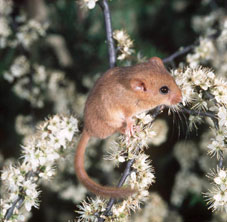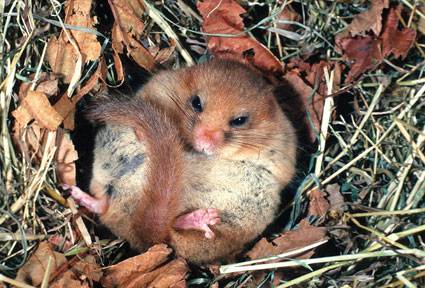The Dormouse - Healthy Life Essex
Home » Articles » Outdoor Life » Wildlife » Mammals » The Dormouse
The Dormouse
in Belfairs Nature Reserve
The dormouse (Muscardinus avellanarius) is a shy, secretive, nocturnal mammal usually associated with broadleaved woodland, ancient hedgerows and old orchards.
 The dormouse requires a very ‘species rich’ habitat and they have a varied diet that includes the nectar and pollen of flowers, fruit, berries and nuts. Food sources must be present within a comparatively small area, as they will not normally travel much more than seventy metres away from their chosen nest site. The species occurs in a population density of no more than ten adults per hectare and they can live for up to five years. They may raise one or two litters, usually of around four young, each year.
The dormouse requires a very ‘species rich’ habitat and they have a varied diet that includes the nectar and pollen of flowers, fruit, berries and nuts. Food sources must be present within a comparatively small area, as they will not normally travel much more than seventy metres away from their chosen nest site. The species occurs in a population density of no more than ten adults per hectare and they can live for up to five years. They may raise one or two litters, usually of around four young, each year.
They differ from other mice and have a characteristic long bushy tail, attractive golden-brown fur and prominent black eyes. Adults weigh between 16-22g although this increases to about 30g prior to hibernation. Hibernation usually takes place between October and April on or near the ground in a nest under vegetation or between tree roots. During hibernation body temperature approaches that of its surroundings and heart and breathing rates drop by 90% or more. The dormouse has the ability to enter temporary torpid states during the summer if temperatures drop or there is a scarcity of food. This ability has probably resulted in its reputation as being ‘sleepy’, as illustrated in the famous mad hatter tea party scene in the Alice in Wonderland story.
Nationally, the dormouse has declined and disappeared from around half of its former range in the last hundred years or so. However, there has been much effort to manage woodlands where it still occurs in ways that encourage a rich habitat. Coppicing, for example, helps to retain the diversity necessary.
 Locally there are records for nests in Hadleigh Great Wood (Belfairs Nature Reserve) in 1958, 1977, 1983 and 1984. However, after a gap of almost twenty years a hibernating dormouse was discovered in 2002 in Dodds Grove during a joint management working party by the South East Essex Conservation Volunteers and South Essex Natural History Society.
Locally there are records for nests in Hadleigh Great Wood (Belfairs Nature Reserve) in 1958, 1977, 1983 and 1984. However, after a gap of almost twenty years a hibernating dormouse was discovered in 2002 in Dodds Grove during a joint management working party by the South East Essex Conservation Volunteers and South Essex Natural History Society.
The establishment of a ‘Dormouse Group’, identification of the current distribution of dormice and the establishment of a rolling programme of nest boxes to help boost the number of potential nesting opportunities were among the Key Objectives within the LBAP (Southend Borough Council Local Biodiversity Action Plan).
In 2004 the Southend Dormouse Group was established. Early surveying generated positive results. One of the Group members successfully secured a Dormice Licence which, because of their protected nature, is required to handle them. The dormouse is protected by both European and UK laws and it is an offence to interfere or disturb the species.
In 2006 the Dormouse Group were able to place up nest boxes and begin to study the local />population through monthly checks. The reserve has now also joined the network of sites providing information to the National Dormouse Monitoring Scheme.
The results were very exciting. For example, 24 animals were found distributed within the 28 boxes in October. It was particularly satisfying to record six litters of young dormice, totalling 22, in the nest boxes and of these, four litters were of three young and two litters were of five young.
The last three years have produced a fantastic experience for the Southend Dormouse Group, which now has 33 members, and we are beginning to understand the distribution of dormice within the nature reserve.
There are plans to increase the number of nest boxes in the nature reserve over the next few years and to look at other woodland in this area. If you are interested in finding out more about the Dormouse Group then please contact Paul Terry, Environmental Officer at Southend-on-Sea Borough Council, Essex on (01702) 215602
or e-mail: paulterry@southend.gov.uk.
